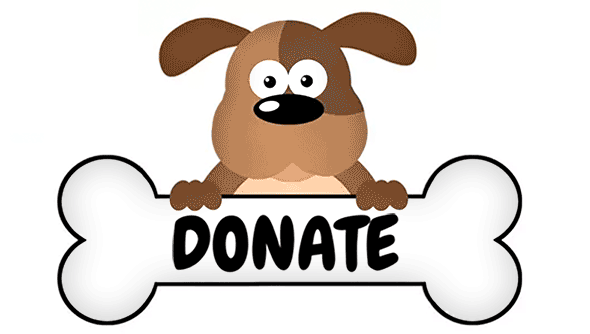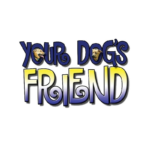
Lawrence, adopted from OBG Cocker Spaniel Rescue, makes this face when he hears thunder.
Fear of Thunderstorms
Fear of thunderstorms can be particularly difficult to “treat” because of the number of factors involved – noise, static, air pressure, lightning, wind, rain, and dark skies. There is a range of responses, from mild anxiety to phobia. Mild anxiety can become more severe, especially after a particularly bad storm. Thunder phobia also tends to develop between the ages of 2 and 4. So, recognize your dog’s signs, and start working with your dog to alleviate some of his symptoms early.
Your Dog’s Response
Dogs recognize the signs of an impending storm before it arrives. You may notice more pacing, drooling, panting, whining, dilated pupils, dandruff or excess shedding, sweaty paws, and a rapid heartbeat.
Your dog may follow you around the house, look for a place to hide, or, if you’re not home, become destructive in an attempt to get away.
Some dogs try to wait out the storm in a bathroom, where the metal pipes are grounded, providing some protection from built-up static charges.
A dog’s response to thunderstorms is physical, emotional, and physiological. When a dog’s cortisol level rises, his state of anxiety increases. It also takes time to dissipate. So, even though the storm has ended, your dog’s sense of well-being will not immediately return.
Helping Your Dog Ahead of Time
There are a number of calming tools, but there isn’t one that works for all dogs. Experiment with some, and see which works best for your dog. Then, use what works at random times, so that it doesn’t predict a storm coming. Use any prescription medication only as directed by your veterinarian.
These tools may include:
- Thundershirts or Anxiety Wraps, that fit snuggly, like swaddling a baby;
- Storm Defenders, wraps designed to dispel static electricity;
- DAP (dog appeasing pheromone) diffusers or collars; calming caps (to cut down the visual stimulation);
- TTouch (body work, movement exercises, and wraps );
- Various homeopathic remedies, like Rescue Remedy or Chill Out spray for dogs;
- Calming music;
- Short-term anti-anxiety medication prescribed by your veterinarian. (Drug therapy, used alone, will not treat thunder fear or phobia, but it can make other methods you use more effective.)
Watch if your dog has a safe space he tends to go when anxious. This is likely to be a small, cozy area, like under the stairs, bed, or table. Make sure that your dog has access to this area at all times.
If your dog is phobic, rather than mildly anxious, a well-prepared safe room could be a lifesaver. Consider an area like a basement, if you have one, which is insulated from sound and has few, if any, windows. Leave an open crate, water, treats, and something safe to chew. Your dog must be able to come or go to this area on his own, even when you’re not home. Spend time playing with your dog in his safe place when it’s not storming, and sometimes feed him there. You want your dog to think of this room as a place where good things happen.
Some dogs are particularly bothered by the noise of thunder. In these cases, you can desensitize your dog to the noise ahead of time, while also helping him to associate the noise with good things happening. Numerous apps with storm sounds are available to use for the desensitization process. Play the sound at a very low volume, while giving your dog treats or playing with a favorite toy or game. As your dog seems comfortable at one volume, you can turn the volume up slightly. Don’t forget to continue giving your dog treats and/or playing with him during this process.
Make sure your dog has an identification tag, and microchip your dog. Some dogs may run away or even jump out a window to try to escape from what’s scaring them. These dogs get lost during thunderstorms, and may end up at the shelter.
During the Storm
When you first notice your dog getting anxious, which is likely to be even before the storm arrives, distract him with a fun game or training cues. Reward him for paying attention to the game or training. This likely won’t help as the storm becomes stronger, but it may delay your dog’s fearful behavior longer each time a storm comes.
When you hear thunder in the distance, use food or play to help your dog begin to change his association with the storm. Do this immediately after the thunder clap, so that the thunder predicts something good. As the thunder becomes louder, though, it’s time to stop, so that you don’t overwhelm your dog.
Turn on lights to reduce the impact of lightning.
If your dog is anxious, rather than phobic, make sure your dog has access to his safe area. For example, if a storm is predicted when you won’t be home and your dog feels most safe under your bed, leave the bedroom door open.
If your phobic dog is sticking by your side and you have a safe room, go with your dog to that room. This will encourage your dog to go to the area of the house where he will feel most protected. If it’s in the basement, you have the advantage of concrete walls and small or no windows.
Use the calming tools that you have already tested and practiced using – a wrap, DAP (dog appeasing pheromone) or whatever else has been working.
Play classical or other calming music. You can find classical music for pets at www.musicmypet.com. “iCalmPet” music and other products at www.iCalmPet.com were developed specifically to help calm dogs. Play music just loud enough to drown out distant thunder. If it’s too loud, your dog will feel overwhelmed by competing noises.
You can use a white noise machine or fan to help reduce outdoor sounds.
Despite what you may have heard, comforting your dog will not reinforce his fear. Under no circumstances would your dog choose to feel panic, regardless of whether petting and cuddling accompany it. Instead, comforting your dog can help your dog get through the storm with less anxiety. If you have learned TTouch body work, this would be a good time to use it.
What Not To Do
Do not punish your dog for his response to the storm. That will make your dog’s fear worse.
Do not close off your dog’s safe space when a storm is expected, especially if you’re not home. This may mean leaving the door to the basement or bathroom open.
Do not crate your dog to avoid his “destroying” your home. Your dog could hurt himself trying to get out.
Do not purposefully expose your dog to the clap of thunder because you think it’s a way to reduce his fear. Your goal is to help your dog feel less anxious.
Key Points to Remember
- Fear of thunderstorms is a particularly difficult issue to treat, since there are so many factors involved when it storms.
- If you have a dog with thunder anxiety or phobia, you should prepare ahead of time.
- Try various calming tools to see which works best.
- Have a safe room away from exterior walls and windows. Your dog should have easy access to his safe place, whether it’s a basement, bathroom, or a hidden corner, like under a desk, stairway or bed.
- Make sure your dog has an identification tag and is microchipped.
- Start desensitizing your dog to the sound of thunder and pair it with something your dog likes.
- Consult with your veterinarian about medication, if your dog has a severe reaction to thunderstorms.
- Dogs know when it will storm beforehand. It’s time to start helping your dog when you first notice his signs of anxiety. At this early stage, you should be able to distract him.
- During the storm, try to help your dog change his association with thunder using food or play after each thunder clap.
- Turning on lights will make lightning seem less intense.
- Classical music or a CD from iCalmPet can help calm many dogs. White noise machines or fans can also reduce outside noise.
- You can help your dog through the storm by comforting him. This will NOT reinforce your dog’s fear.
Resources
CD’s at www.iCalmPet.com (developed by veterinary neurologist, Susan Wagner, and Joshua Leeds, an expert in psychoacoustics) – www.throughadogsears.com.
“The Big Bang – How You Can Help Your Dog Cope With Thunderstorms and Fireworks” by Claudeen McAulifee
Blogs by Patricia McConnell on thunder and sound sensitivity-http://www.patriciamcconnell.com/thunder-phobia-and-sound-sensitivity
“How to ‘Cure’ Your Dog of Thunderstorm Phobia” by Dr.Nancy Becker at www.mercola.com
Still Need Help?
Contact Your Dog’s Friend at [email protected] or (301)983-5913 for advice and referrals or check out our list of recommended trainers and behaviorists.
Your Dog’s Friend is a nonprofit 501(c)(3) organization working to improve dogs’ lives, reduce problem behaviors, and keep dogs out of shelters, by educating and supporting their humans.
This material is not intended to be a substitute for professional help when dealing with dogs with intense or potentially dangerous behavior issues. Consult a positive reinforcement trainer or veterinary behaviorist for professional assessment, guidance, and support.




